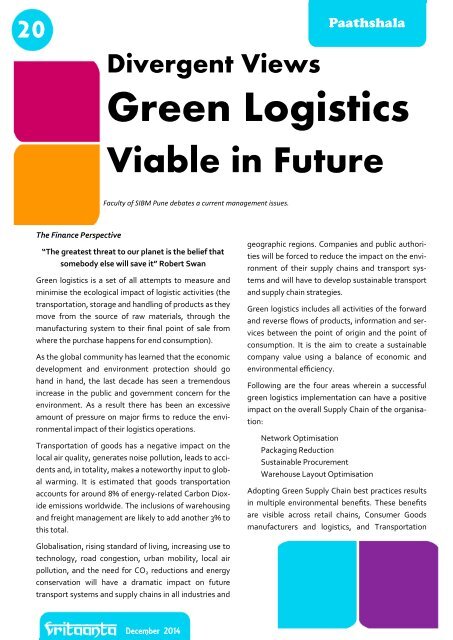Vritaanta December 2014
The Monthly Magazine of SIBM Pune
The Monthly Magazine of SIBM Pune
You also want an ePaper? Increase the reach of your titles
YUMPU automatically turns print PDFs into web optimized ePapers that Google loves.
20<br />
Paathshala<br />
Divergent Views<br />
Green Logistics<br />
Viable in Future<br />
Faculty of SIBM Pune debates a current management issues.<br />
The Finance Perspective<br />
“The greatest threat to our planet is the belief that<br />
somebody else will save it” Robert Swan<br />
Green logistics is a set of all attempts to measure and<br />
minimise the ecological impact of logistic activities (the<br />
transportation, storage and handling of products as they<br />
move from the source of raw materials, through the<br />
manufacturing system to their final point of sale from<br />
where the purchase happens for end consumption).<br />
As the global community has learned that the economic<br />
development and environment protection should go<br />
hand in hand, the last decade has seen a tremendous<br />
increase in the public and government concern for the<br />
environment. As a result there has been an excessive<br />
amount of pressure on major firms to reduce the environmental<br />
impact of their logistics operations.<br />
Transportation of goods has a negative impact on the<br />
local air quality, generates noise pollution, leads to accidents<br />
and, in totality, makes a noteworthy input to global<br />
warming. It is estimated that goods transportation<br />
accounts for around 8% of energy-related Carbon Dioxide<br />
emissions worldwide. The inclusions of warehousing<br />
and freight management are likely to add another 3% to<br />
this total.<br />
geographic regions. Companies and public authorities<br />
will be forced to reduce the impact on the environment<br />
of their supply chains and transport systems<br />
and will have to develop sustainable transport<br />
and supply chain strategies.<br />
Green logistics includes all activities of the forward<br />
and reverse flows of products, information and services<br />
between the point of origin and the point of<br />
consumption. It is the aim to create a sustainable<br />
company value using a balance of economic and<br />
environmental efficiency.<br />
Following are the four areas wherein a successful<br />
green logistics implementation can have a positive<br />
impact on the overall Supply Chain of the organisation:<br />
Network Optimisation<br />
Packaging Reduction<br />
Sustainable Procurement<br />
Warehouse Layout Optimisation<br />
Adopting Green Supply Chain best practices results<br />
in multiple environmental benefits. These benefits<br />
are visible across retail chains, Consumer Goods<br />
manufacturers and logistics, and Transportation<br />
Globalisation, rising standard of living, increasing use to<br />
technology, road congestion, urban mobility, local air<br />
pollution, and the need for CO 2 reductions and energy<br />
conservation will have a dramatic impact on future<br />
transport systems and supply chains in all industries and<br />
<strong>December</strong> <strong>2014</strong>






